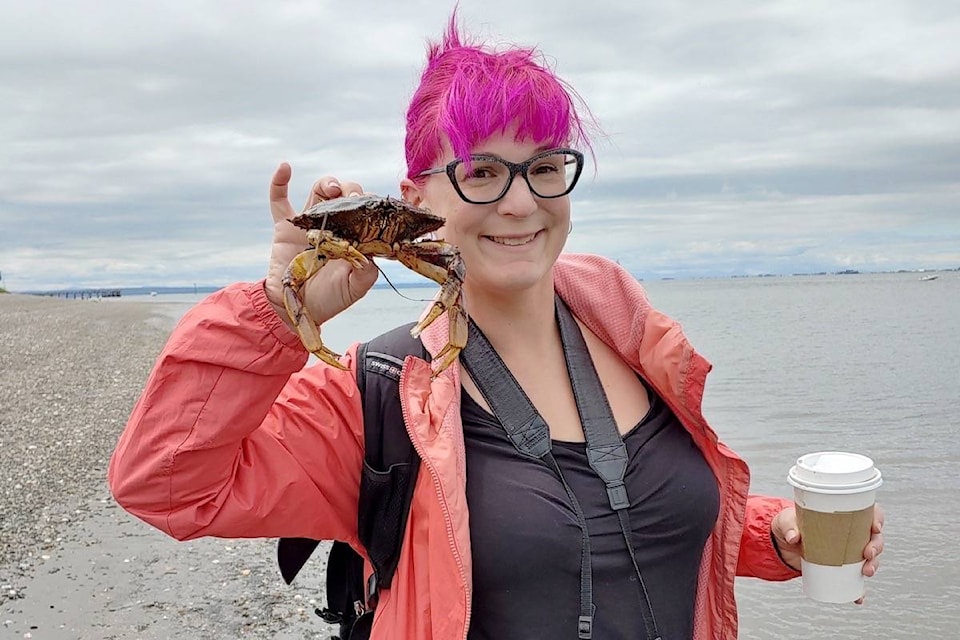An invasive crustacean described as one of the world‚Äôs top-10 unwanted species has made its way to Blackie Spit in South Surrey ‚Äď as well as other nearby marine habitats ‚Äď and efforts are underway to curtail its spread.
The European Green Crab ‚Äúwill eat anything that fits in its mouth,‚ÄĚ Lori Schlechtleitner ‚Äď a biologist/ecologist contracted by Friends of Semiahmoo Bay Society to set up a local management program ‚Äď said Sept. 25, during field work in Blackie Spit.
And that non-discriminating palate, along with a high resiliency to water temperatures and salinity and a distinct lack of predators to keep them in check, is bad news for native species.
‚ÄúYou‚Äôve got to respect it for being so incredibly adaptive,‚ÄĚ Schlechtleitner said of the spiny crab. ‚ÄúBut it does have the potential to decimate.‚ÄĚ
The crab, which can range in colour from dark mottled green to orange, is native to European and North African coastlines, and was first found in Canadian waters in 1951. It’s believed they arrived in B.C. between 1998 and 1999.
They are currently found along the entire west coast of Vancouver Island, and have an established population at the southern tip, in Sooke.

Schlechtleitner said a survey in early September just south of the border found 145 of the invasive crabs, while officials with DFO found ‚Äújust one or two‚ÄĚ in Blackie Spit both last year and last month. She said the reason behind the discrepancy between the two sets of numbers is unclear.
What is clear is that their presence is a problem that can‚Äôt be ignored. They have done substantial damage on Canada‚Äôs East Coast, she said. Left unchecked here, they will predate everything from oysters to juvenile crabs to eelgrass beds ‚Äď a critical home for juvenile salmon ‚Äď and alter the local shoreline ecosystem and habitats.
‚ÄúOn the Pacific Coast, they will brood up and eat the eelgrass beds, which is why we‚Äôre really concerned,‚ÄĚ Schlechtleitner said.
‚ÄúOnce they start to take a leghold, that‚Äôs when the ecosystem might not, unfortunately, make it back.‚ÄĚ
Schlechtleitner and volunteer Dave Shorter‚Äôs mission on Sept. 25 was to set a dozen traps in two channels that run through Blackie Spit‚Äôs protected salt marsh. Baited with cat food and staked 10 metres apart, they were left overnight to see if any of the unwelcome, trapezoid-shaped creatures were present. None were found, Schlechtleitner told Peace Arch —«÷řŐžŐ√ in an emailed update on Sept. 30.
The results were the same for traps set in the Little Campbell River estuary, on Semiahmoo First Nation land, the week prior, as well as for traps set off the base of 64 Avenue on Sept. 29. More traps were set at Delta’s Centennial Beach on Sept. 30.

The four locations were identified by DFO as priority management sites and will remain under close eye ‚Äúfor the foreseeable future,‚ÄĚ Schlechtleitner said.
Schlechtleitner, who lives in Vancouver but grew up in Surrey, said for her, the effort is ‚Äúa passion project.‚ÄĚ It‚Äôs hoped that community groups will get involved, perhaps by adopting channels to monitor, or walking wrack lines ‚Äď the line of debris left on the beach by high tide ‚Äď after trapping season is over, to look for molts on the beaches.
‚ÄúThis is going to be a long-term management process,‚ÄĚ Schlechtleitner said.
Friends of Semiahmoo Bay Society has committed to the project for the long-term, society president Margaret Cuthbert noted.

‚ÄúSince we have mapped 86 hectares of eelgrass in Boundary Bay and conducted the DFO 3-5 year Shorekeepers (program) for over 15 years, our Marine Coordinator Matt Christensen and our Board of Directors agree we must now focus our volunteer activities and funds to this crucial concern,‚ÄĚ Cuthbert told PAN by email.
READ MORE:
VIDEO:
The City of White Rock has contributed funding to the effort, Schlechtleitner noted, but more is needed.
The ultimate goal, she said, is for the management efforts to reap only native-species results.
‚ÄúThat‚Äôs the goal of this project, is to not find what we‚Äôre looking for.‚ÄĚ

Anyone who spots one of the crabs ‚Äď they measure up to 10 cm across the back shell, and have three bumps between the eyes as well as five ‚Äúspines‚ÄĚ to the outside of each eye ‚Äď is asked to leave it where it is, but email a photo and details of its exact location (ideally, GPS co-ordinates) and the date it was observed to aispacific@dfo-mpo.gc.ca
tholmes@peacearchnews.com
Like us on and follow us on



